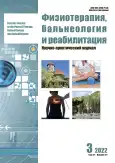SOME FEATURES OF THE EFFECT OF DIFFERENT METHODS OF MEDICAL REHABILITATION ON THE INTENSITY OF PAIN SYNDROME IN PATIENTS AFTER AN ISCHEMIC STROKE IN THE LATE RECOVERY PERIOD
- Authors: Mikhailova A.1, Korchazhkina N.B.1, Kotenko K.V.1, Koneva E.S.1
-
Affiliations:
- Petrovsky National Research Centre of Surgery
- Issue: Vol 21, No 3 (2022)
- Section: Original studies
- URL: https://journals.rcsi.science/1681-3456/article/view/108078
- ID: 108078
Cite item
Abstract
Post-stroke complications include pain in the upper limb, which affects the performance of simple movements, reduces the level of daily life activity and, as a result, the quality of life of patients. Materials and methods. The paper presents data on the effectiveness of the influence of various methods of medical rehabilitation in the late recovery period in 120 patients with ischemic stroke on pain intensity (according to the digital pain rating scale and the Verbal Descriptive Pain Assessment Scale), activity of daily life and quality of life . All patients were divided into 3 groups comparable in terms of clinical and functional characteristics: group 1 (40 patients), who, in addition to the standard treatment complex, were prescribed massage with a pulsed low-frequency electrostatic field from the Khivamat apparatus and broadband modulation currents (TSM), group 2 ( 40 patients), who, against the background of standard therapy and medical rehabilitation, were included in physiotherapy methods from the Alpha™ LED Oxy Light - Spa™ device, a group of 3-40 patients who received standard drug therapy and medical rehabilitation (exercise therapy, medical massage, mechanotherapy). Results. The data obtained indicate the advantage of including in the standard complex of medical rehabilitation and treatment of patients who have had ischemic stroke with movement disorders in the form of hemiparesis of a pulsed low-frequency electrostatic field and broadband modulation currents (BWM). In the course of the work, it was proved that the use of the developed rehabilitation program contributes to a significant reduction in pain syndrome, and positively affects the assessment of the quality of life of patients after the course of treatment. This was confirmed by the improvement in the index of activity of daily life and data from scales and questionnaires. Conclusions. Inclusion in medical rehabilitation of patients who have had an ischemic stroke with movement disorders in the form of hemiparesis with an increase in muscle tone of pulsed low-frequency electrostatic massage and broadband modulation currents affects the reduction of pain, the expansion of daily activity and the improvement of the quality of life of patients.
Full Text
##article.viewOnOriginalSite##About the authors
Anna Mikhailova
Petrovsky National Research Centre of Surgery
Author for correspondence.
Email: mikhaylova003@gmail.com
ORCID iD: 0000-0002-4260-1619
Candidate of Medical Sciences, Associate Professor, Head of the Scientific and Educational Center in Petrovsky National Research Centre of Surgery
Russian Federation, Абрикосовкий переулок, д.2Natalia Borisovna Korchazhkina
Petrovsky National Research Centre of Surgery
Email: n9857678103@gmail.com
ORCID iD: 0000-0002-9804-7725
SPIN-code: 9733-7646
Scopus Author ID: 36931563000
Doctor of Medical Sciences, Professor, Head of the Scientific and Educational Center
Russian Federation, Абрикосовкий переулок, д.2Konstantin Valentinovich Kotenko
Petrovsky National Research Centre of Surgery
Email: noc@med.ru
ORCID iD: 0000-0002-6147-5574
SPIN-code: 5993-3323
Scopus Author ID: 5993-3323
Doctor of Medical Sciences, Professor, Corresponding Member of the Russian Academy of Sciences, Director
Russian Federation, Абрикосовкий переулок, д.2Elizaveta Sergeevna Koneva
Petrovsky National Research Centre of Surgery
Email: elizaveta.coneva@yandex.ru
ORCID iD: 0000-0002-9859-194X
SPIN-code: 8200-2155
Scopus Author ID: 55676603900
Doctor of Medical Sciences, Professor of the Department of Sports Medicine and Medical Rehabilitation, Sechenov First Moscow State Medical University (Sechenov University)
Russian Federation, Абрикосовкий переулок, д.2References
- Danilov, V.I. Stroke. Modern approaches to diagnosis, treatment and prevention / V.I. Danilov, D.R.Khasanova - M.: GEOTAR - Media, 2014. - 248 p.
- Barlak, A. Poststroke shoulder pain in Turkish stroke patients: relationship with clinical factors and functional outcomes / A. Barlak, S. Unsal, K. Kaya, S. Sahin-Onat, S. Ozel S. // Int J Rehabil Res. –2009. –No. 32(4). -R.309-315.
- Certificate of state registration of the database No. 2021621887 Russian Federation. Database of scientific research on the medical rehabilitation of patients after acute cerebrovascular accident: No. 2021621759: Appl. 08/26/2021 : publ. 09/06/2021 / A. A. Mikhailova, K. V. Kotenko, N. B. Korchazhkina, E. S. Koneva; applicant Federal State Budgetary Scientific Institution “Russian Scientific Center for Surgery named after academician B.V. Petrovsky".
- Physical and rehabilitation medicine: national leadership / G. R. Abuseva, P. V. Antipenko, V. V. Arkov [and others]; Interregional Scientific Society of Physical and Rehabilitation Medicine, Association of Medical Societies for Quality. - Moscow: Limited Liability Company "GEOTAR-Media" Publishing Group, 2020. - 688 p. – (National guidelines). – ISBN 9785970455548.
- Epifanov V.A., Korchazhkina N.B., Epifanov A.V. Medical and social rehabilitation of patients with various pathologies. In 2 parts / ed. S.V. Yablonsky. T. II. Moscow: GEOTAR-Media, 2019. 560 p. ISBN: 978-5-9704-4947-9 [Epifanov V. A., Korchazhkina N. B., Epifanov A. V. Medical and social rehabilitation of patients with various pathologies. In 2 parts / edited by S. V. Yablonsky. Vol. II. Moscow: GEOTAR-Media, 2019. 560 p.]
- Korchazhkina, N.B., Mikhailova, A.A. Features of the use of stabiloplatforms with biofeedback in various socially significant diseases / N. B. Korchazhkina, A. A. Mikhailova // Physiotherapy, balneology and rehabilitation. - 2019. - T. 18. - No. 2. - S. 103-106. – doi: 10.17816/1681-3456-2019-18-2-103-106.
Supplementary files






